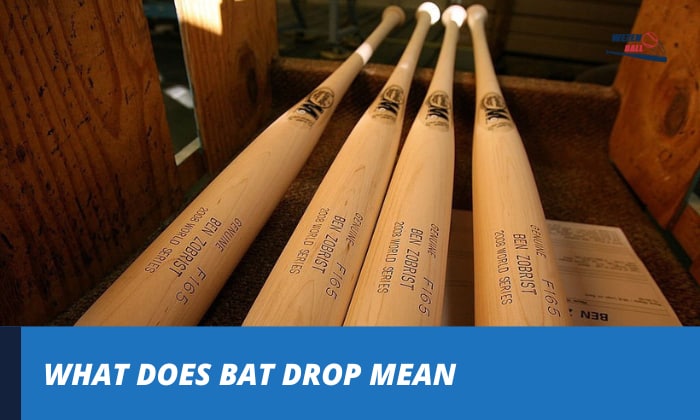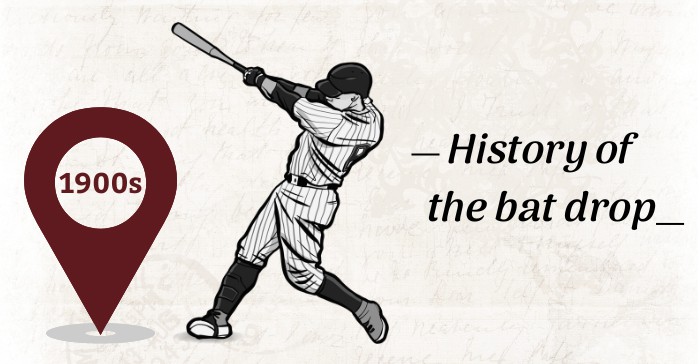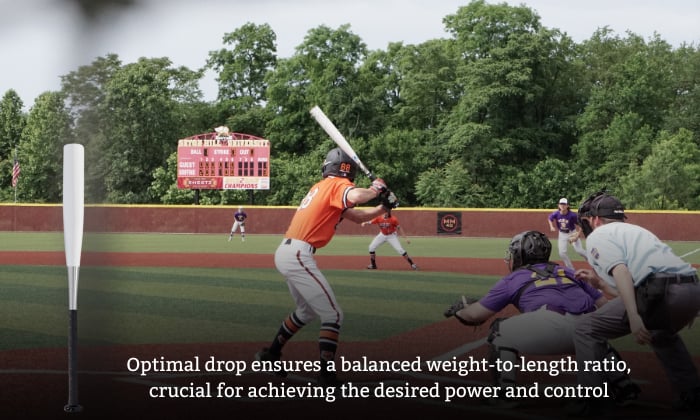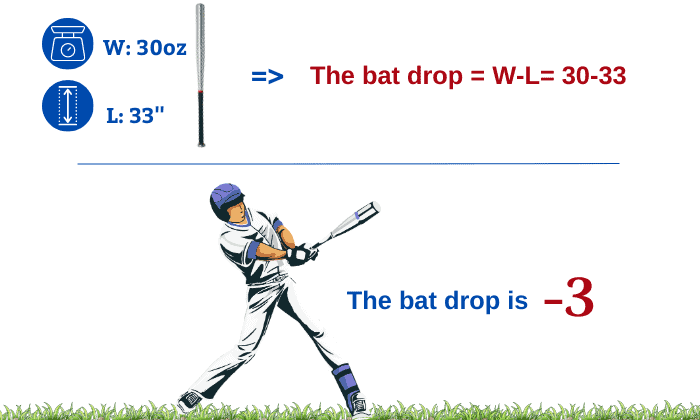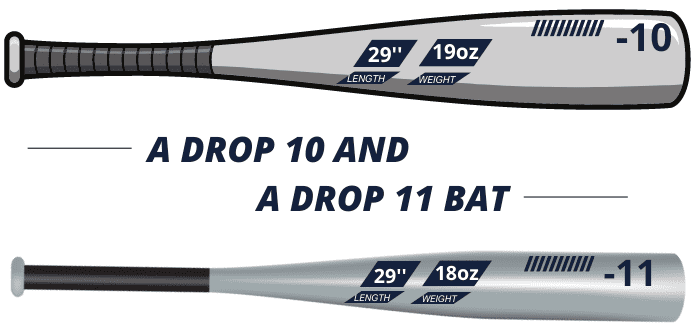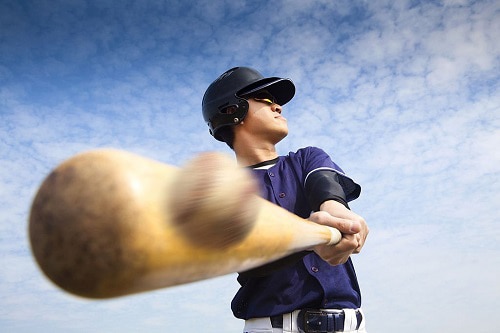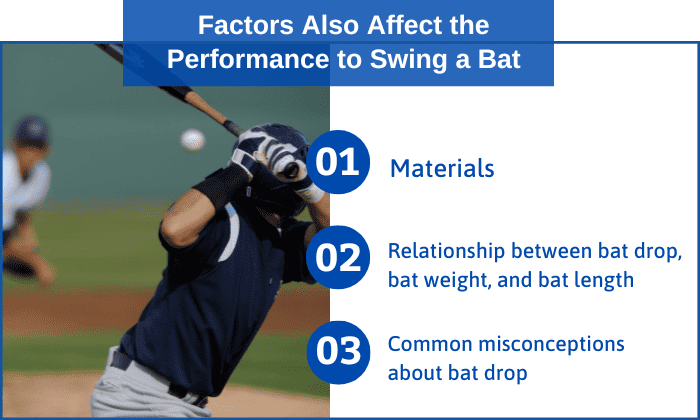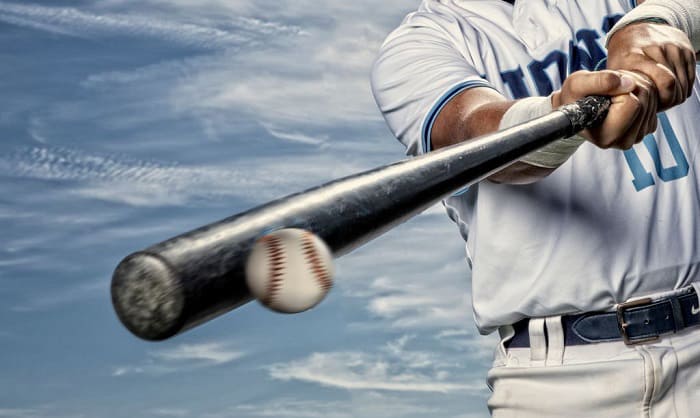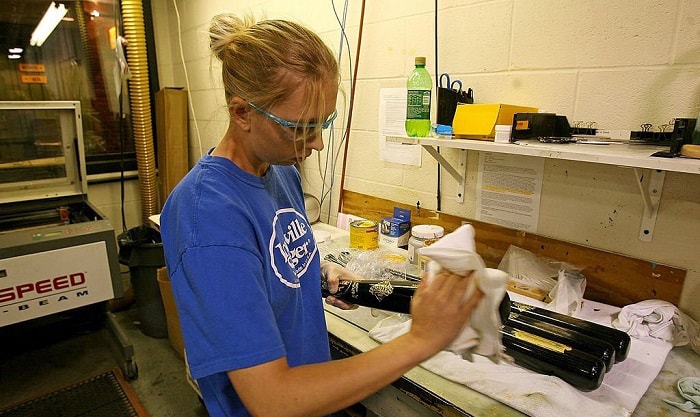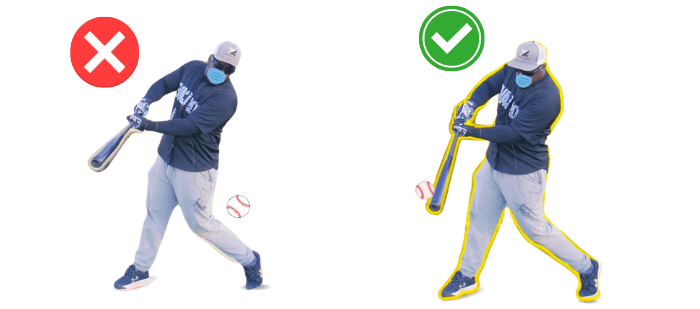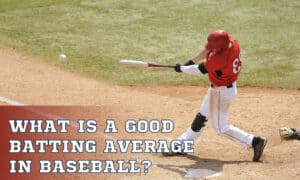A bat is one of the most essential components in baseball. Choosing the wrong bat can lead to bad situations, resulting in injury or disqualification. Many might not know that part of the criteria for picking the right bat is the bat drop.
To answer your question, what does bat drop mean? , it is a numerical representation of a bat’s weight-to-length ratio, expressed as a negative number.
To further your knowledge about this fundamental concept, let us dive deeper into the topic.
Contents
- About the Bat Drop
- How Bat Drop is Calculated
- Why Bat Drop Matters
- Factors Also Affect the Performance to Swing a Bat
- Tips for Selecting the Appropriate Bat Drop
- Tips for Finding the Perfect Bat
- Tips for Maintaining and Caring for Your Baseball Bat
- How to Improve Your Swing With the Right Bat Drop
- FAQs
- Conclusion
About the Bat Drop
1. Meaning
Bat drop, often referred to as drop weight bat, is a fundamental term in baseball that describes the variance between a bat’s weight and length.
This critical measurement is determined by subtracting the length of the bat, typically measured in inches, from its weight, measured in ounces.
For instance, a bat measuring 29 inches long and weighing about 20 ounces will have a bat drop of -9, as the result of the calculation: 20 – 29. Therefore, the bat will be classified as a drop 9.
2. History of the bat drop
The history of drop number on bats traces its roots to the early 1900s, a time when players predominantly wielded heavy and thick bats. As the game evolved, players recognized the advantages of lighter bats, which offered faster swings and improved control.
This realization led to the development of bats with lower drops, signifying a decrease in the weight-to-length ratio.
3. Importance of the bat drop figure
Selecting a bat with the ideal drop can profoundly impact a player’s performance on the field. Optimal drop ensures a balanced weight-to-length ratio, crucial for achieving the desired power and control.
An excessively high drop, resulting in a lighter bat, may compromise power generation, leading to weaker hits. Conversely, an extremely low drop, indicating a heavier bat, can hinder swing speed and impede control.
When choosing a baseball bat, it is essential to consider not only the drop but also factors like length, material, and grip. Finding the right combination of these elements is a personalized process.
How Bat Drop is Calculated
As stated above, calculating the drop on a bat is a straightforward process that involves subtracting the length of the bat (measured in inches) from its weight (measured in ounces).
Let’s see some more examples:
- Consider a bat weighing 30 ounces and measuring 33 inches in length. Subtracting the length from the weight yields 30 – 33 = -3. In this example, the bat drop is -3.
- Let’s explore another scenario where a bat weighs 28 ounces and measures 31 inches in length. By applying the formula, we subtract the length from the weight: 28 – 31 = -3. Here, the bat drop also amounts to -3.
It’s important to note that the resulting bat drop value is expressed as a negative number. A higher negative number signifies a greater weight-to-length ratio, indicating that the bat is relatively heavier for its length.
Why Bat Drop Matters
1. Impact of different drop values on performance
The choice of bat drop significantly influences a player’s swing speed and power output. Understanding the relationship between drop value and performance is vital for optimizing results on the field.
- For instance, let us make a comparison between a drop 10 and a drop 11 bat. When you compare a drop 10 vs drop 11 bats, even a one-ounce difference can yield noticeable effects on a player’s performance.
A drop 10 bat meaning is that there is more mass behind each swing, potentially resulting in increased power upon ball contact. Players who prioritize power-hitting and possess the necessary strength to handle the slightly heavier weight often prefer this type of bat.
- Conversely, a drop 11 bat, being lighter, allows for enhanced bat speed due to its reduced weight. This facilitates quicker swings and improved bat control, appealing to players who value rapid bat acceleration and maneuverability during their at-bats.
Although the discrepancy of just one ounce may seem minimal, its impact on swing speed, power, and control is tangible.
2. How bat drop affects swing speed and power
Furthermore, bat drop subtly affects swing mechanics and power potential. A light bat with a high drop value facilitates a more effortless swing, but it may sacrifice some power in the process.
On the other hand, a heavier bat with a lower drop value demands more strength to swing effectively, but it can deliver increased power and improved control.
3. Printed vs. actual bat weights
The weight printed on a bat represents the manufacturer’s intended or “target” weight, but it may not always align precisely with the actual weight of the bat received by the player.
Numerous factors contribute to the variation in actual bat weights. The bat materials’ density, whether wood or another material, can impact the final weight. Additionally, variations in manufacturing processes can result in slight deviations from the intended weight.
- This discrepancy between printed and actual bat weights can be a source of confusion and frustration for players seeking precise weight specifications.
- Players need to be aware of what is drop weight on a bat, as the actual weight can influence factors such as swing speed, control, and overall performance.
- To mitigate these challenges, coaches and parents must take matters into their own hands by independently weighing bats.
Factors Also Affect the Performance to Swing a Bat
Mastering the art of swinging a bat is fundamental in both baseball and softball, and it involves considering several crucial factors, such as the bat’s materials, bat drop, bat weight, and bat length.
1. Materials
The choice of materials significantly influences the swing performance. Wooden bats, prevalent in professional leagues, offer an authentic feel and sound but tend to be heavier with a smaller sweet spot, demanding more precision.
Aluminum bats, lighter and easier to swing, boast a larger sweet spot for forgiving hits, albeit with a different feel and sound.
Composite bats, blending wood and aluminum characteristics, deliver an expanded sweet spot and a more forgiving experience.
2. Relationship between bat drop, bat weight, and bat length
The relationship between bat drop, bat weight, and bat length also holds great importance.
Bat drop indicates the weight differential between bat length and weight. A higher bat drop denotes a lighter bat, enhancing swing speed and maneuverability. However, lighter bats compromise power due to reduced mass and momentum.
Bat weight and length further impact swing performance. Heavier bats generate greater power but can be more challenging to swing and may result in slower bat speeds. Longer bats offer a larger hitting zone but require additional control and finesse.
When selecting a bat, it is crucial to strike a balance between the desired swing characteristics and personal preferences.
Players must consider their skill level, strength, hitting style, and league regulations to determine the optimal combination of materials, bat drop, weight, and length.
3. Common misconceptions about bat drop
There are 3 common misconceptions regarding bat drop in baseball.
- First, a higher bat drop doesn’t always equate to a better bat. While a lighter bat aids in generating bat speed, it may compromise power. Striking a balance between bat drop and weight is crucial for maintaining power and control.
- Secondly, assuming that a heavier bat guarantees more power is another misconception. While a heavier bat can offer additional power, it can also hinder swing speed and overall performance.
- Lastly, the notion that a longer bat always results in a larger hitting zone is not entirely accurate. Although a longer bat can extend the hitting area, it can be challenging to control, particularly for players with smaller physiques or shorter arms.
Tips for Selecting the Appropriate Bat Drop
1. Bat drop guidelines for different leagues
For Major League players, there is a maximum bat length of 44 inches, but no minimum length or weight limit is specified. However, specific leagues can establish weight regulations through collective bargaining agreements.
In the case of MLB player’s leagues, a separate agreement has been reached, setting a maximum bat length and a permitted drop of -3.5.
In some leagues like the YB, the youth baseball bat drop should be between -10 and -12.
2. Recommended drop values for different ages and skill levels
Listed below are the values of bat drop by age:
| Player’s age | Recommended bat drop | Important note regarding skill levels |
| For 7 year old | Between -10 and -12 | Light bat allows for easier swing mechanics. |
| For 9-year old | Between -10 and -11 | This range strikes a balance between bat control and power generation |
| For 10 year old | Between -9 and -11 | Important to develop more strength and coordination while maintaining good swing speed and control. |
| For 12 year old | Between -8 and -10 | Develop more power behind their swings while still focusing on maintaining bat speed and control.
|
|
For 14 year old |
Between -5 and -8 | Gain more power potential while still emphasizing control and maintaining bat speed. |
For more information, refer to the bat drop chart below. You can see the varying bat drop weight by age and the bat drop weight chart:
| Weight | Height | |||||||||
| 3′-3’4″ | 3’5”-3’8″ | 3’9”-4′ | 4′-4’4″ | 4’5”-4’8″ | 4’9”-5′ | 5’1″-5’4″ | 5’5″-5’8″ | 5’9″-6′ | 6’1″-over | |
| Under 60 Lbs | 25″/26″ | 27″ | 28″ | 29″ | 29″ | |||||
| 61-70 | 27″ | 27″ | 28″ | 29″ | 30″ | 30″ | ||||
| 71-80 | 28″ | 28″ | 29″ | 30″ | 30″ | 31″ | ||||
| 91-100 | 28″ | 29″ | 29″ | 30″ | 30″ | 31″ | 32″ | |||
| 101-110 | 28″ | 29″ | 30″ | 30″ | 31″ | 31″ | 32″ | |||
| 111-120 | 29″ | 29″ | 30″ | 30″ | 31″ | 31″ | 32″ | |||
| 121-130 | 29″ | 29″ | 30″ | 30″ | 31″ | 31″ | 32″ | |||
| 131-140 | 29″ | 30″ | 30″ | 30″ | 31″ | 32″ | 33″ | 33″ | ||
| 141-150 | 29″ | 30″ | 30″ | 31″ | 31″ | 32″ | 33″ | 33″ | ||
| 151-160 | 30″ | 30″ | 31″ | 31″ | 32″ | 33″ | 33″ | |||
| 161-170 | 30″ | 31″ | 31″ | 32″ | 32″ | 33″ | 33″ | 33″ | ||
| 171-180 | 31″ | 31″ | 32″ | 32″ | 33″ | 33″ | 34″ | |||
| over 180 | 32″ | 33″ | 33″ | 34″ | 34″ | |||||
| 33″ | 33″ | 34″ | 34″ | |||||||
| Most Popular Length by Age | ||||||
| Age | 5-7 | 8-9 | 10 | 11-12 | 13-14 | 15-16 |
| Length | 24″-26″ | 26″-28″ | 28″-29″ | 30″-31″ | 31″-32″ | 32″-33″ |
Tips for Finding the Perfect Bat
Finding the perfect baseball bat sizing requires a personalized approach, considering factors such as bat drop and materials used. Try out different bats with varying drops and see which one feels comfortable for you.
Tips for Maintaining and Caring for Your Baseball Bat
When it comes to maintaining baseball bats, the level of care required depends on the material.
Carbon composite or metal bats are low-maintenance, requiring a wipe-down with a cloth after each game. These bats are designed to be corrosion-resistant, so there is minimal concern.
However, if you’re using wooden bats, proper maintenance is crucial for optimal performance and to prevent issues like poor performance and warping. Follow these steps to maintain your wooden bats:
- After each game, wipe the bats using a dry cloth.
- Keep your wooden bats dry at all times.
- Condition your wooden bat by grinding it against another bat, similar to sharpening knives.
- Store your bats vertically, with the handle facing upwards. This helps prevent warping and deformity, ensuring the bat maintains its shape over time.
How to Improve Your Swing With the Right Bat Drop
Test out a range of bats with varying bat drops to determine which one feels most comfortable and enables you to generate the desired swing speed and power. Once you’ve got the perfect bat for you, practice until you’ve got used to it.
Keep in mind that the right bat drop has the potential to substantially enhance your overall performance at the plate, providing improved swing mechanics and greater effectiveness.
FAQs
Can I change the bat drop on my existing bat?
It’s not possible to change the bat drop on your existing bat. It’s based on the specific weight and length ratio that is designed to optimize performance and comply with regulations. Attempting to alter the bat drop would involve physically modifying the bat.
How do bat drops differ between baseball and softball?
In baseball, the standard bat drop usually falls within the range of -3 to -13, with lower drops being more common among older players.
On the other hand, softball bats have larger bat drops. In fastpitch softball, bat drops typically range from -8 to -13.5, while in slowpitch, they typically range from -5 to -13.
These variations exist because of the distinct ball sizes and playing dynamics in each sport. Players need to be aware of these differences and adhere to the specific bat drop regulations set by their respective leagues.
Is there a standard bat drop for all players?
There is no standard bat drop for all players. These baseball bat numbers are only guides for you to determine what kind of bat you want to get, a hard-hitting bat or a swift-hitting one, and what kind of bat is optimal for you.
Conclusion
Now that you know the answer to your question, “What does bat drop mean?” you’ll be able to comprehend the concept, the significance, and the influence on the performance of bat drop in baseball.
By tailoring the bat drop according to age and skill level, players can optimize their swing mechanics.
Moreover, understanding the impact of materials and league regulations is crucial. Armed with this knowledge, players can make well-informed choices to unlock their hitting potential and elevate their game to new heights.

A powerful swing and the ball is flying across the field, just one hit, and we might never forget the thrill it brings. I do not know about you, but I never do. Every baseball game is the chance to compete with others and cooperate with your teammate. It is among my biggest passions.



